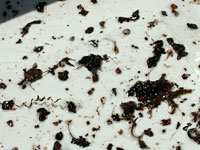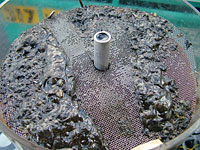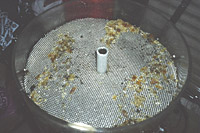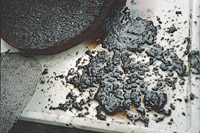About Diesel Bug
Which bugs are present in diesel?
The organisms currently most frequently found in diesel fuel include moulds, yeasts and bacteria. The main mould isHormoconis resinae, the main yeasts are Yarrowia Lipolytica & Candida Kerosenii and the most common bacterium isPseudomonas Aeriginosa. These organisms are believed to work as a consortium known as the diesel bug, living in the moisture generated by condensation and feeding off the alkanes in the fuel. As may be expected from fast reproducing organisms, new variants are always potentially evolving.
Diesel bug microbes thrive wherever there is food and water. Marine diesel fuel systems are therefore ideal habitats for bacteria, yeastsand moulds. The trend towards biofuels is creating pressure for reducing sulphur and increasing biofuel content. Sulphur kills bugs and biofuels contain additional water, so the changing fuel specifications are set to make marine diesel fuel an even more bug friendly environment. The diesel bug when grown unchecked can block fuel filters and stop engines. They are so corrosive that they can eat through even stainless steel fuel tanks, over time.




What is Fuel Polishing
Fuel polishing is the process of removing contamination such as water and particles from fuel to ensure that it remains in line with fuel specifications. Ideally, fuel should have an ISO particle code of 18/16/13 and a dissolved water content no greater than 200 parts per million. There should be no free or emulsified water present.
Fuel polishing will ensure that the fuel is ‘clean and dry’ meaning free from water and dirt thereby reducing the possibility of engine or fuel system.
Diesel Testing
The first and most obvious test is to perform a visual inspection of your fuel system. Checking the filters, tanks, fillers and site tubes.
Apart from a visual check and in-tank testing we offer our clients two other forms of more comprehensive microbial tank testing.
The Conidia Bioscience – Fuelstat test.

The Conidia Bioscience Marine test is an immunoassay test (rather like a pregnancy test). This detects diesel bug contamination by “finding” material that is produced by the 3 different types of diesel bug contamination that grow in fuel. Therefore there is no need to capture part of the living organism and grow it. This is important as the fungus (H.res.), – the diesel bug does not only float around at the water/fuel interface, it also sticks to the bottom or sides of the tank.
Laboratory Testing
For a more comprehensive test we will submit samples of your fuel to a laboratory for analysis. The lab they will grow the microbes that have been taken from a sample of your fuel. These will be grown in their lab and from the analysis of this they will be able to send a comprehensive report detailing exactly what is growing in your tank.
Then together we will pan the most effective method of decontaminating both your tank and your fuel
Talk to us about putting in place a regular testing regime for you so that we keep ahead of the problem. Don’t wait until you have the problem.
